President Trump Tried to Work Within the System
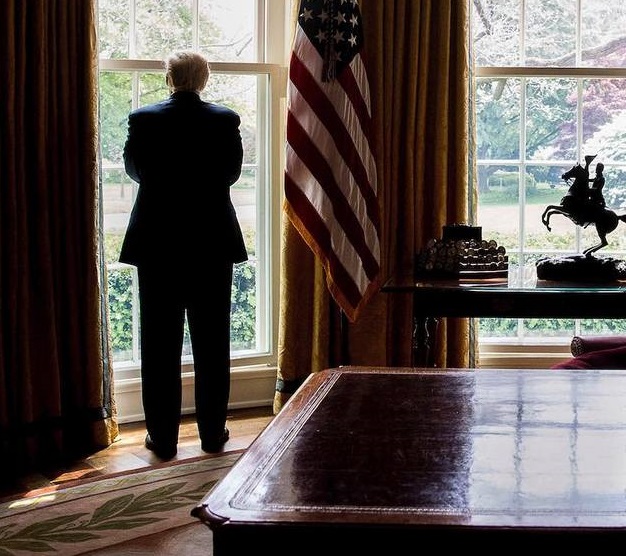 In the spring and summer of 2018 everyone became aware of the DOJ and FBI collective effort to target President Trump under the false guise of a Trump-Russia collusion claim.
In the spring and summer of 2018 everyone became aware of the DOJ and FBI collective effort to target President Trump under the false guise of a Trump-Russia collusion claim.
It must have been extremely frustrating for a sitting president to know there was nothing to the claims yet be constantly bombarded by media and political people in Washington DC who held a vested interest in maintaining them.
By the time we get to September of 2018 the basic outline of the FBI use of the Trump-Russia targeting operation were clear. However, the Robert Mueller investigation was at its apex, and anyone in/around Donald Trump was under investigation for ancillary issues that had nothing to do with Russia.
It was into this fray of constant false narratives that President Trump first made statements that he would declassify documents related to his targeting. It was after Trump made those statements when the real motives of putting Robert Mueller as a special counsel became clear.
With Attorney General Jeff Sessions recused from anything to do with the Trump-Russia investigation, it was Deputy Attorney General Rod Rosenstein who delivered the message to President Trump in September of 2018, shortly before the midterm election, that any action by him to release documents, now under the purview of the Mueller special counsel, would be considered an act of “obstruction” by the DOJ/FBI people charged with investigating him.
Immediately after meeting with Rod Rosenstein, Trump tweeted:
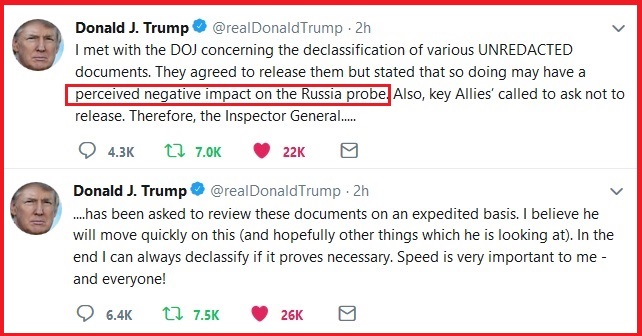
This was the first act of betrayal by political operatives within Main Justice who did not recognize or accept the concept of the ‘unilateral executive.’ According to Rod Rosenstein, FBI Director James Comey, Deputy FBI Director Andrew McCabe, and even later (including recently) AG Bill Barr, the office of the president cannot exercise unilateral executive authority when he himself is the subject of their investigative power.
In essence the DOJ and FBI, along with white house counsel and a collaborating senate and media, kept President Trump from declassifying and releasing documents by threatening him with impeachment and/or prosecution if he defied their authority. The threats created a useful Sword of Damocles, and blocked Trump from acting to make documents public.
In the months that followed President Trump frequently made public statements and tweets about the frustration of documents not being declassified and released despite his instructions to do so. Many Trump supporters also began expressing frustration.
The external debate and consternation surrounded how the Administrative State has seemingly boxed-in President Trump through the use of the Mueller/Weissman counterintelligence probe, authorized by Rod Rosenstein, where President Trump was the target of the investigation.
A widely held supporter perspective was that President Trump could expose the fraudulent origination of the counterintelligence investigation; of which he is now a target; if he were to declassify a series of documents as requested by congress and allies of his administration. This approach would hopefully remove the sword of Damocles.
The core issue within the debate surrounded two contradictory reference points: (1) President Trump has ultimate declassification authority. Yes; however, in this example President Trump is also the target of the investigation; so, (2) declassification could be viewed by elements within the investigation as ‘obstruction’. Both of these points were true.
Also true was the reality that both laws and politics were in play.
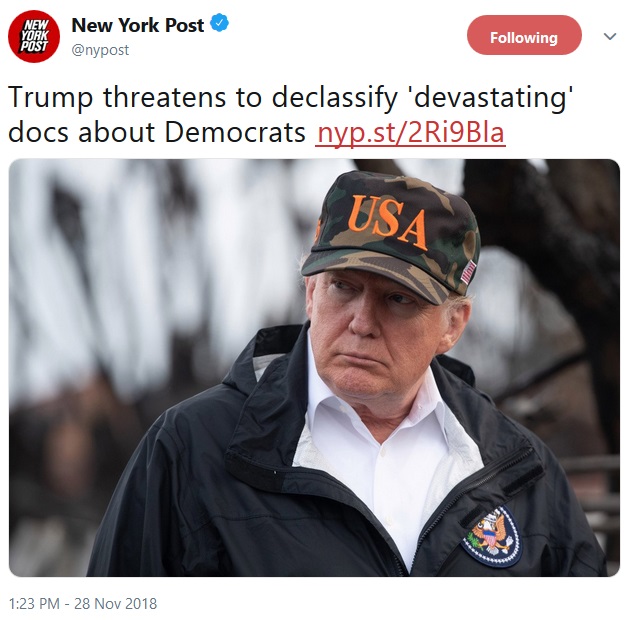 In November 2018 President Trump gave an interview where he discussed the situation as it was visible to him. Democrats and republican opposition, writ large, were working earnestly to remove him from office.
In November 2018 President Trump gave an interview where he discussed the situation as it was visible to him. Democrats and republican opposition, writ large, were working earnestly to remove him from office.
Here’s a link to the General Principles of declassification [SEE HERE] Yes, the President can declassify anything; however, there is a process that must be followed. Executive order 13526 [Citation Here]
Following that declassification process the Office of the Director of National Intelligence, then Dan Coats, and the FBI Director, Christopher Wray, and the Attorney General, in this example Rod Rosenstein, needed to “sign-off” on the declassification.
The process reasoning is simple in the ordinary (non-corrupt) flow of events. The intelligence agencies might need to protect part of the information, such as “sources or methods” of intelligence contained within the classified material.
Under ordinary declassification procedures the President would likely not want to compromise the ‘sources’ and ‘methods’ and would defer to the intelligence experts.
President Trump is aware of material that he can use to defend himself from the ongoing ‘impeachment’ plans of Nancy Pelosi and Chuck Schumer. However, President Trump is also seemingly aware of the issues within the process to gain access to the material and actually use it. This is where the concentric circle of lawyers around the Office of The Presidency come into play.
We have the constitution, we have laws, and we have politics.
Moving forward there are three background threads that are critical to understanding how this process has unfolded so far:
- The Declassification Conundrum.
- Understanding the Ramifications of President Trump as a target.
- Understanding how intelligence is compartmented.
All three of these issues come into play.
Unfortunately, if you have not already invested the time in those three aspects it is easy, very easy, to get lost.
Because none of the legal linguistics took into account the reality of the actual process for declassifying information, many people were stuck thinking President Trump held sole authority to classify and declassify intelligence without understanding the process.
Declassification of intelligence is a process, and each person -within the executive branch- inside the process must agree to the process. Making the process even more riddled with issues is the reality that President Trump was the target in a counterintelligence investigation. President Trump was being investigated by Mueller to see if he is under the direct or indirect influence of a foreign power. [In this example, Russia]
The Mueller probe is an originating counterintelligence investigation that ‘can find’ espionage (see Russian indictments) as well as violations of law (Papadopoulos, Manafort, Flynn). It is critical to remember, the originating probe is not a criminal probe; but Mueller and Weissmann can charge criminality if the investigators encounter interference of their counterintelligence probe; these are the process crimes (perjury, obstruction, lying to congress); or if the probe uncovers direct criminal activity (tax evasion, money laundering, FARA violations etc.).
Yes, technically President Trump can declassify anything. However, it is also true that technically POTUS doesn’t actually declassify anything. The Office of the President asks for a document to enter into a declassification review process.
Officials within that process (ODNI, DoD, DoS, FBI, DOJ-NSD, CIA, NSA, etc), based on their unique relationship to the interests within the document(s), can approve or refuse to sign-off based on their specific intelligence interests. This is where compartmented intelligence comes into play.
Any officer who refuses the request for declassification must justify to the intelligence hub; the Office of the Director of National Intelligence (ODNI, Dan Coats). The executive branch intelligence official tells the ODNI (Dan Coats) why they, their unique interests, cannot approve of the declassification request.
DNI Dan Coats then informs POTUS why the document is not cleared for declassification.
If he disagrees with the decision of the intelligence official, POTUS then would have to fire, replace and hope the next person in the chain-of-command would sign-off. Given the nuance in the example of President Trump declassifying information that would show he was targeted, and considering the President is under a counterintelligence cloud it was unlikely any officer would break ranks.
President Trump would have to fire people, and keep firing people, until he gets to a person, inside that specific agency, who would comply.
Now stop and be reasonable.
Think about the general political ramifications to that decision. And then think about the ramifications against the reality that President Trump is a target, under the cloud of a counterintelligence probe.
President Trump asks DNI Dan Coats (intelligence hub) to coordinate the declassification of [fill_in_blank]. If he agrees, in November of 2018 Dan Coats then asks all of the compartmented principles with interest in that specific document. That likely includes the DOJ (after the midterm it’s Matt Whitaker), FBI (Chris Wray), and likely DoS (Mike Pompeo – because of the State Dept aspect to Chris Steele). Also, possibly the NSA and/or Cyber Command.
If FBI Director Christopher Wray refuses to declassify the document(s) because it is part of the current Mueller counterintelligence probe, of which Trump was a target, then President Trump would have to fire Chris Wray; and, while awaiting a replacement (Senate confirmation seriously doubtful), the request then falls on FBI Deputy Director David Bowdich. [Who would also likely refuse]
As this hypothetical declassification example is unfolding you can imagine the political damage being carried out. In addition, there’s the looming impeachment process waiting to start. Hopefully, you can see how President Trump could easily be accused of interference or obstruction of justice. So, he had to wait for Mueller to finish.
Here comes the second betrayal and threat.
Mueller completed his investigation in April of 2019.
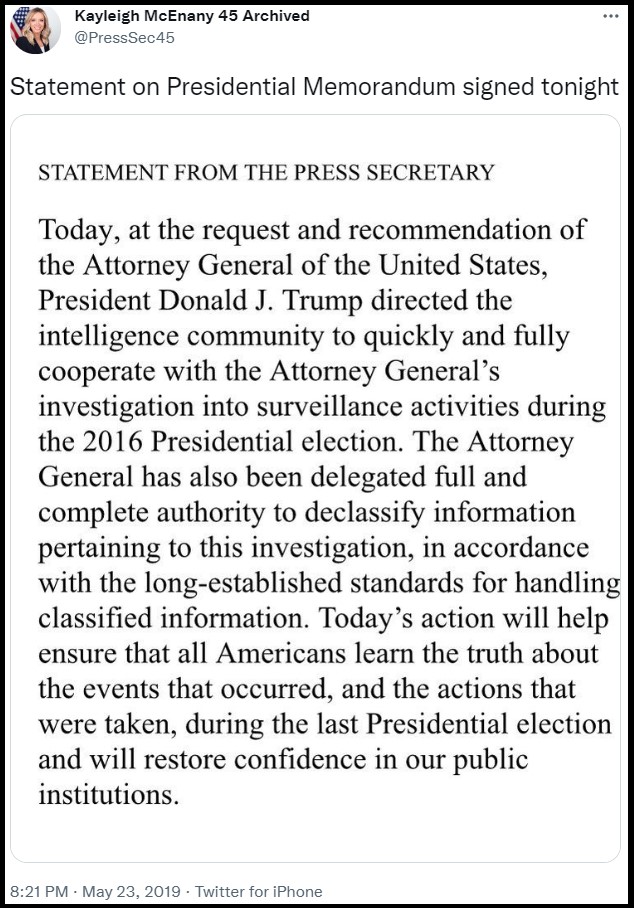 Within a few weeks, May 2019, the newly appointed and confirmed Attorney General Bill Barr tells President Trump to remove himself from the declassification issue and give him the authority to declassify and release documents because Barr has an investigator (John Durham) to look into the corrupt activity behind the Trump-Russia collusion hoax.
Within a few weeks, May 2019, the newly appointed and confirmed Attorney General Bill Barr tells President Trump to remove himself from the declassification issue and give him the authority to declassify and release documents because Barr has an investigator (John Durham) to look into the corrupt activity behind the Trump-Russia collusion hoax.
Ten days before he made the request, Bill Barr had enlisted John Durham to look into all of the issues surrounding the targeting of President Trump and the Clinton campaign involvement in the creation of the Trump-Russia collusion story.
At the time most people thought what Barr was doing was a good thing. As a result, President Trump agrees to support Bill Barr and on May 23, 2019, delegates the declassification and release to the Attorney General.
The President is trusting his cabinet officer, the highest law enforcement officer in the country, to do the right thing and expose the wrongdoing he has been the subject of for the past two years.
It was an easy sell, because the purpose of declassification was ultimately to facilitate a DOJ review of how the intelligence apparatus was used in the 2016 election.
However, because the DOJ review encompassed intelligence systems (DOJ, FBI, NSA) potentially weaponized in 2016 for political purposes and intents, a strange dynamic existed.
President Trump carries: (a) declassification authority; but also: (b) an inherent conflict.
In the DOJ endeavor using John Durham, candidate Trump would have been the target of corrupt agency activity; and therefore, Trump would be considered the target/victim if weaponization were affirmed by evidence collected by Durham.
To avoid the conflict President Trump designated the U.S. Attorney General as arbiter and decision-maker for the purposes of declassifying evidence within the investigation:
…”The Attorney General has also been delegated full and complete authority to declassify information pertaining to this investigation, in accordance with the long-established standards for handling classified information.”
Additionally, AG Bill Barr did not need to assemble the intelligence product for approval by the executive (Trump). Instead, the office of the president is granting the AG full unilateral decision-making as to each product being considered for declassification.
At the time we noted, this was a huge amount of trust from the President to the Attorney General, and a big responsibility for William Barr:
[Sec 2] …”With respect to any matter classified under Executive Order 13526 of December 29, 2009 (Classified National Security Information), the Attorney General may, by applying the standard set forth in either section 3.1(a) or section 3.1(d) of Executive Order 13526, declassify, downgrade, or direct the declassification or downgrading of information or intelligence that relates to the Attorney General’s review referred to in section 1 of this memorandum.”
The position-designate slightly works around custom insofar as the intelligence hub, the Office of the Director of National Intelligence (Dan Coats), is given conference – but the decision-making was designated to the Attorney General (Bill Barr).
Essentially the DNI will be following the instructions of the AG for this Memorandum. This is slightly unusual; but given the purpose, necessary and expected.
Following protocol, the 2019 Memorandum was specific to the agencies carrying the documentation to be reviewed by the Attorney General: The Secretary of State (Pompeo); the Secretary of Treasury (Mnuchin); the Secretary of Defense (Shanahan); the Secretary of Energy (Perry); the Secretary of Homeland Security (McAleenan); the Director of National Intelligence (Coats); the Director of the CIA (Haspel), and the Attorney General himself (Barr).
Within the memorandum President Trump did not allow AG Bill Barr to delegate authority. However, all agencies were required to respond to Barr’s authority.
The purpose of the Declassification Directive, as it was sold to President Trump, also appeared to permit the DOJ Inspector General to include classified material in the body of the (early 2019) pending report on FISA abuse; this memorandum was granting AG Bill Barr the autonomy to make that decision and declassify that content.
While the purpose of the authority was to empower AG Bill Barr to collect, process and declassify intelligence product that was part of the DOJ investigative review, President Trump did not preclude the public release of intelligence information in advance of the 2019 IG report on FISA abuse.
Much of the intelligence information may be collected external to the IG review parameters (FISA process) and may be released independently as part of stand-alone declassification that pertains to weaponized DOJ, FBI and CIA political activity. Ultimately the decision to release, and the timing therein, was then in the hands of U.S. Attorney General William Barr.
On May 23, 2019, with the Mueller investigation in the rear-view President Trump tweeted:
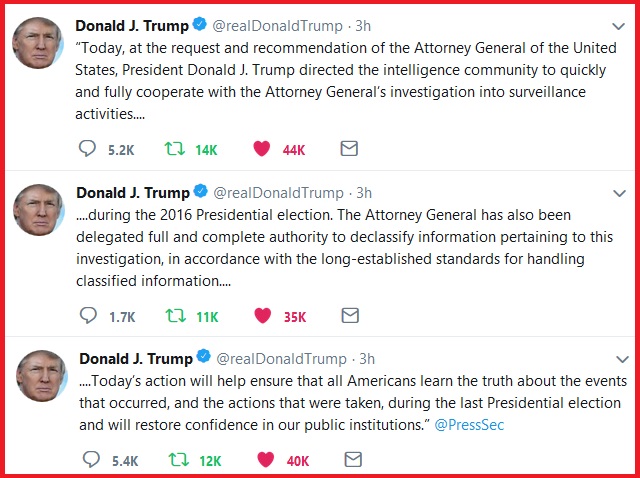
Unfortunately, as time continued throughout 2019, Attorney General Bill Barr took no action that would declassify any material of interest to the targeting of President Trump.
AG Bill Barr used the “ongoing criminal investigation,” led by the man he appointed, John Durham, as a justification for non-release of documents.
Frustration continues to mount as impeachment efforts against President Trump and the painful reality of the Bill Barr motive starts to settle in.
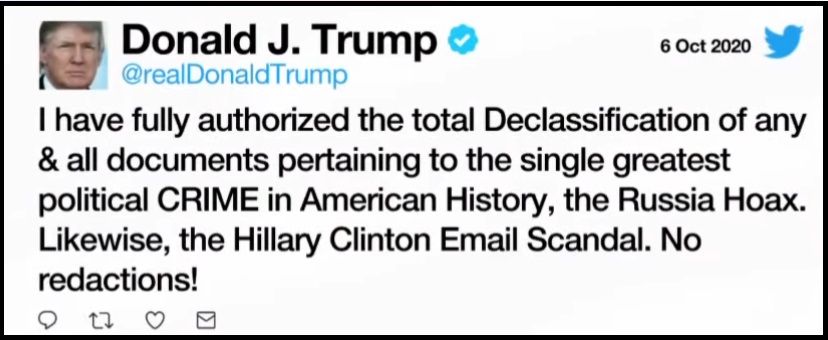
Bill Barr replaced the obstruction and interference threat carried by Mueller special counsel, with the obstruction and interference threat carried by the Durham special counsel. The ‘ongoing investigation‘ narrative created both swords of Damocles. One created by Rosenstein/Mueller the other created by Barr/Durham.
Then Bill Barr did something even worse. He made sure President Trump could never remove it.
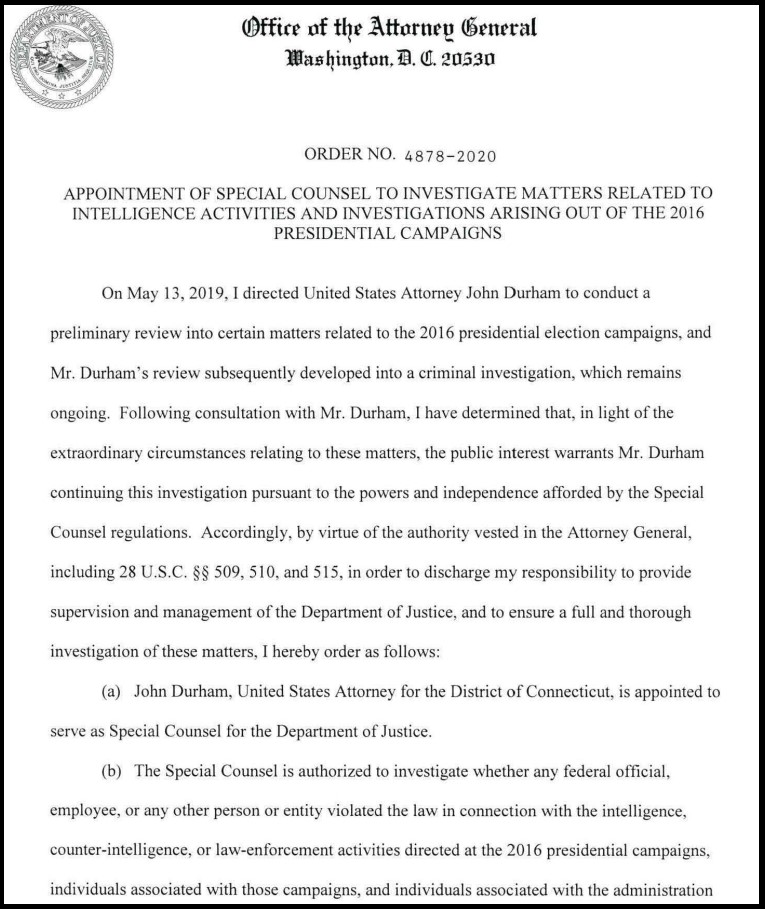
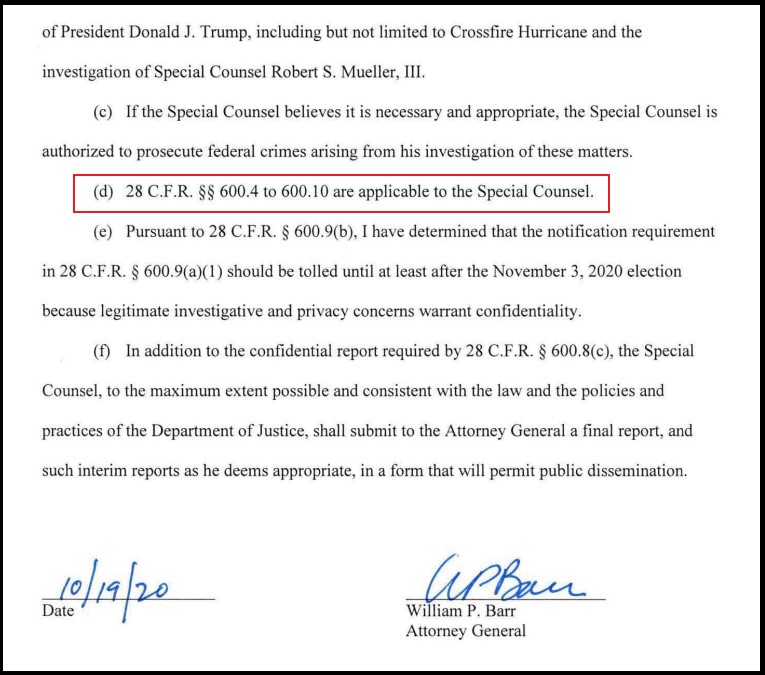
The result?
The special counsel block of investigative material continued from May 13, 2019, all the way to today. The Durham special counsel is an active and ongoing investigation.
This is the dynamic behind the declassification of records.
This is the dynamic where the law is used, structurally weaponized by the institutions who are sworn to uphold it, to protect the interests of the DC Deep State.
This is the dynamic that exposes how the DOJ and FBI are structurally corrupt.
Even as he was departing office, President Trump wanted those documents released. Documents he declassified and outlined in this memo to the DOJ:
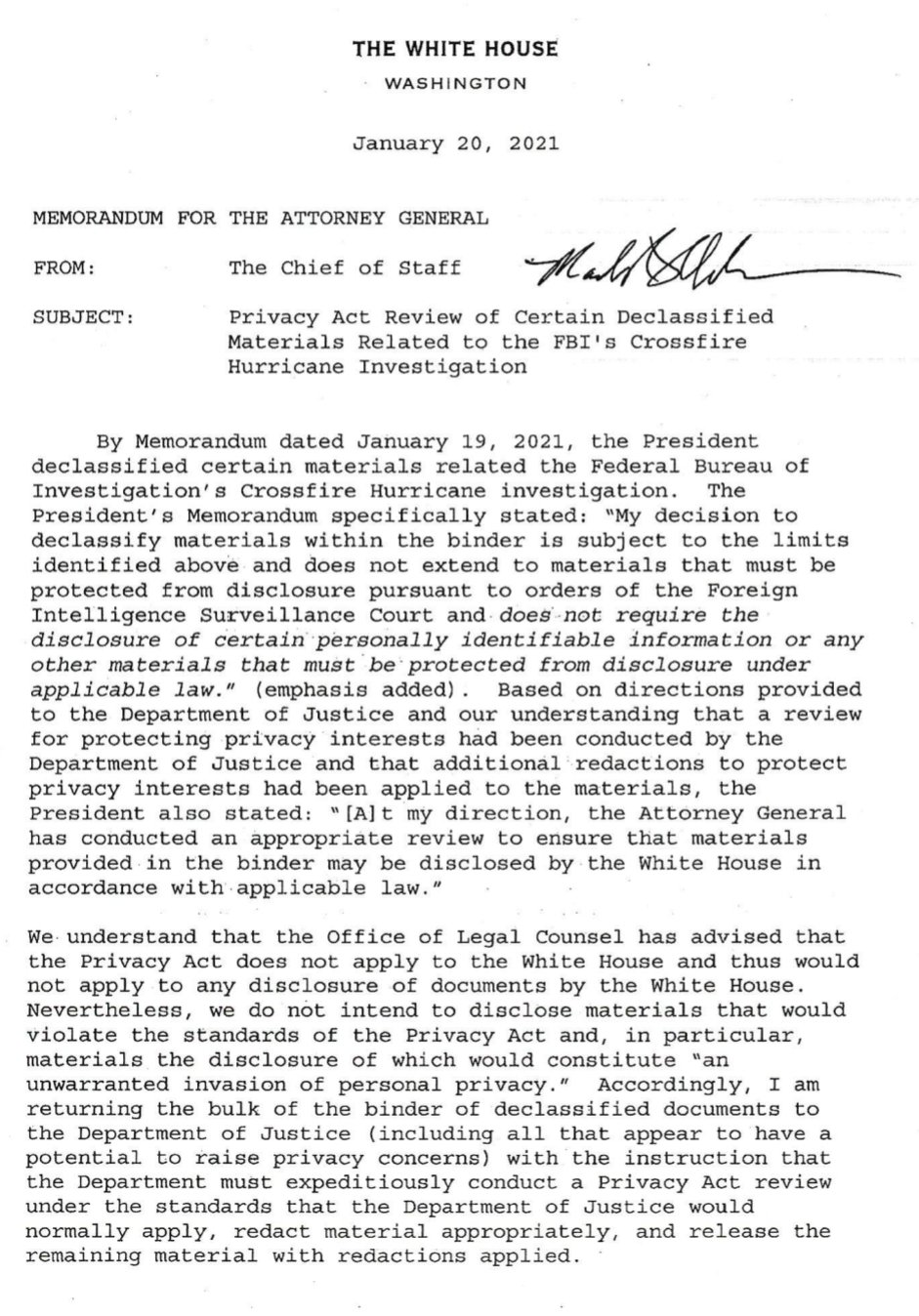
[January 19, 2021, Declassification Directive Link]
This is the heart of the battle over documents between the current DOJ/FBI and President Trump.
Again, the threats of a corrupt administration of justice are at the heart of the issue.
This four-year sequence of events, including all of the betrayals and threats made against Donald Trump, all intended to keep him from allowing the public to see the full nature of the corrupt Deep State operation that lies at the heart of our current political strife, is ultimately what led to an FBI raid on his home in Mar-a-Lago.
This is the scale of the issue.
The DOJ and FBI will do everything they can to stop the release of documents outlining how the system worked to target candidate and President Trump.
If the broader American public understood what tools and surveillance systems were used; if the broad American public knew what the DOJ, FBI, intelligence apparatus and aligned Senate committees have done; if the broad American public became aware of the scale and scope of the corruption in DC as it now exists; entire institutions within that framework would start to collapse.
This is what they are trying to stop. That is the scale of their zero-sum approach.
[ Support CTH Research Here ]
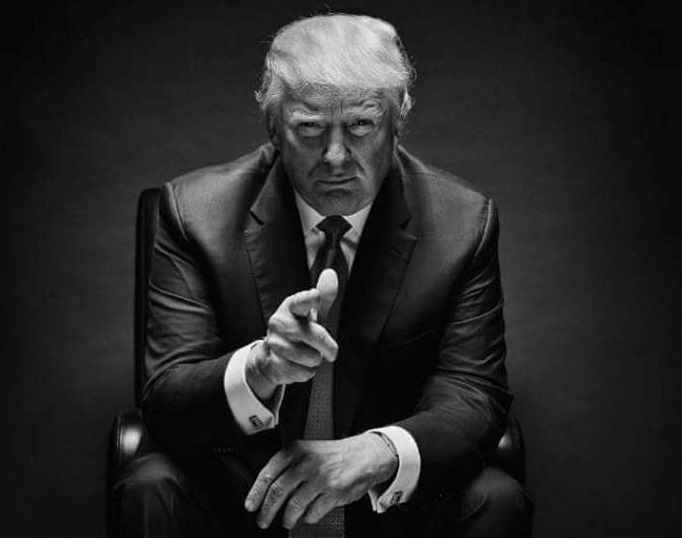




Post a Comment